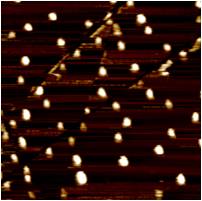Surface nanobubbles
Immersing hydrophobic substrates in water leads to the surprising formation of nanoscopic bubbles adhered to the substrate (Figure 1). These surface nanobubbles are spherical caps, with typical heights and diameters of 15nm and 50nm, respectively.
Several fundamental questions exist, for example:
- Why do surface nanobubbles not disappear through diffusion (they exist for at least 10 orders of magnitude longer than expected for diffusion),
- moreover, how do they form, and
- how are they affected by substrate topography?
To answer these questions, we are using a combination of experimental, numerical (including molecular dynamics), and theoretical techniques. Specific projects include the role of temperature, gas concentration, and the presence of contamination on nanobubble stability, as well as electrostatic effects, and gas attraction towards hydrophobic walls.
The ultimate aims of this research are to understand the behaviour of gas-liquid-substrate interactions at the nanoscale, as well as to control slip in nano/micro-fluidic devices.

Figure 1: 2D height scan of a solid-liquid interface, made by Atomic Force Microscopy. The image size is 5×5 µm².
Info: Detlef Lohse
Researchers: Joost Weijs, Hanneke Gelderblom, James Seddon, Siddhartha Das, Detlef Lohse, Andrea Prosperetti, Jacco Snoeijer, Leen van Wijngaarden
Collaborators: Sezer Caynak (MSc), Stefan Kooij, Bene Poelsema and Harold Zandvliet (Solid State Physics, U Twente)
Embedding: MESA+, JMBC.
Sponsors: FOM, STW, EEC
